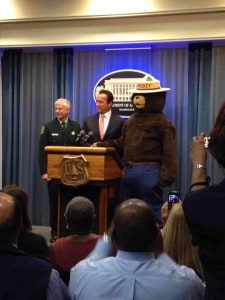The essay below mentions a new generation of tree-sitters, such as those at the White Castle Variable Retention Harvest, a Demonstration Pilot Project designed “for the purpose of illustrating the principles of ecological restoration developed by Drs. Jerry F. Franklin and K. Norman Johnson,” according to the EA. 187 acres, with “78.4 aggregate retention acres.”
www.blm.gov/or/districts/roseburg/plans/files/WhiteCastleDR.pdf
In September, the BLM initiated a Temporary Area Closure for up to 2 years: “The purpose for this proposed action is to quickly implement a temporary closure of the area to public use during active logging operations. The need for action results from the danger to timber sale protesters within harvest units of an active timber sale; risks to personnel engaged in timber harvest operations; and potential damage to roads, vehicles, and equipment.”
Anyone know what’s going on at present with the sale and the protesters? Are the protesters using the same techniques, aside from occupying trees, such as leaving steel “jumping jacks” on roads to puncture tires?
Just background for the essay, from High Country News’ Writers on the Range:
Protesters still take to the trees
By Robert Leo Heilman/Writers on the Range
If you think that sitting high up in a tree to block a timber sale is a thing of the past, then you should have come with me recently to what’s called the Whitecastle timber sale in southern Oregon. There’s a new generation of protesters up in the trees there, and in many ways they’re more sophisticated than the Earth First! radicals I interviewed back in the mid-1980s.
Today’s tree-sitters are much more likely to have been involved in other movements, such as Occupy, or in environmental struggles against coal, tar sands and power plants. There are also a lot more women involved.
Not surprisingly, the sitters can seem abysmally ignorant about some things; they’re young, in their 20s for the most part, and largely raised in cities. Most of them believe that the century-old second-growth forest they’re camping in is old-growth dating back to Shakespeare’s day. But like the folks who blocked roads and chained themselves to logging equipment during the Reagan administration, they are idealists, willing to put their freedom on the line for what they believe in.
Probably the most interesting generational change is that the “old guard” were often elitists, college-educated folks who thought timber workers were too stupid and ignorant to know what was good for them. The kids nowadays want to ally themselves with the workers and take on the bosses alongside them in a fight for both ecological and labor justice.
This is not such a far-fetched notion. When the Reverend Jesse Jackson came to Roseburg, Ore. — which calls itself the timber capital of the nation — at the height of the “Timber Wars” of the early 1990s, he received an ovation from a mixed crowd of timber workers and environmentalists. He brought them to their feet when he said: “This is not about workers against environmentalists; this is about workers and environmentalists against the greedy and the wasteful.”
This change of attitude can be traced back to Judi Bari and Gene Lawhorn. She was an Earth First! activist from the redwood country of Northern California, and he was a mill worker employed by the Roseburg Forest Products Co. After they met in the late 1980s, at the University of Oregon’s annual Environmental Law Conference in Eugene, Lawhorn persuaded Bari to renounce tree-spiking and other activities that could harm loggers or mill workers.
She, in turn, was able to convince her fellow protesters that their struggle was against the bosses, not against the workers. Endangering workers was both morally reprehensible and stupidly playing into the hands of the very folks who were cutting too much timber too fast, even as they cut the wages and benefits for their employees.
Bari went on to become the victim of a bombing attack, surviving that only to die of cancer a few years later. Since her death, she has become something of a saint in leftist radical circles, her name invoked reverently by this new generation. But Gene Lawhorn has been largely forgotten. He had complex views about logging old-growth forests, and he had the courage to voice his opinions. For this he received death threats, beer bottles were smashed in his driveway and the windshield on his pickup was shattered. After he lost his job with Roseburg Forest Products Co., he couldn’t find employment anywhere in Douglas County. Neither could his wife, who found that job offers disappeared as soon as prospective employers heard her last name.
When the local daily newspaper finally published an article about the so-called “timber wars” and the death threats circulating around the county, Gene Lawhorn’s predicament was exposed right in front of God and everybody. Yet not one leader in Douglas County — no politician, preacher, member of law enforcement or of the court system, and no teacher, mill owner or government agency head — spoke out against neighbors threatening to kill their neighbors. There was a letter to the editor of the local weekly, but the writer said that Gene Lawhorn was a traitor who deserved whatever he got. By then, Gene and his wife had already fled to Portland.
The tree-sitters I talked with recently had never heard of this former neighbor of mine, a man who reached out to people whom he’d been told were his enemies. Nevertheless, these kids are now making his argument for him.
Robert Leo Heilman is a contributor to Writers on the Range, a service of High Country News (hcn.org). He is an award winning essayist, author and journalist living in Myrtle Creek, Oregon.



